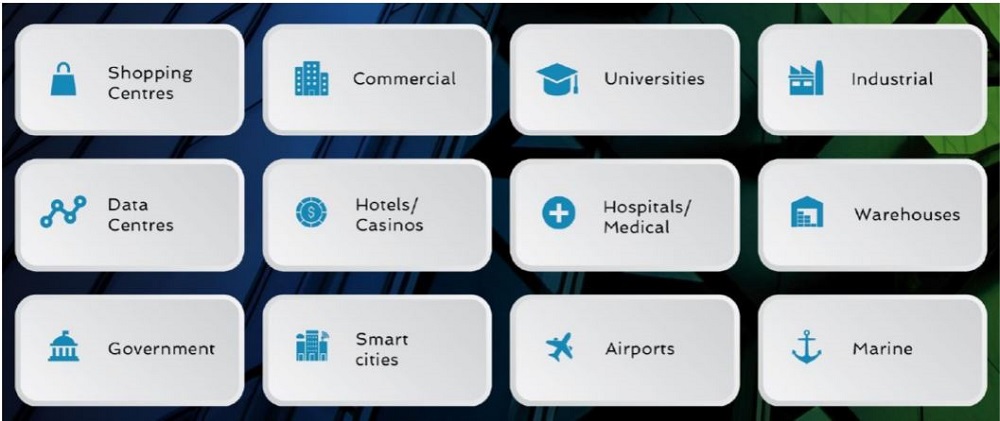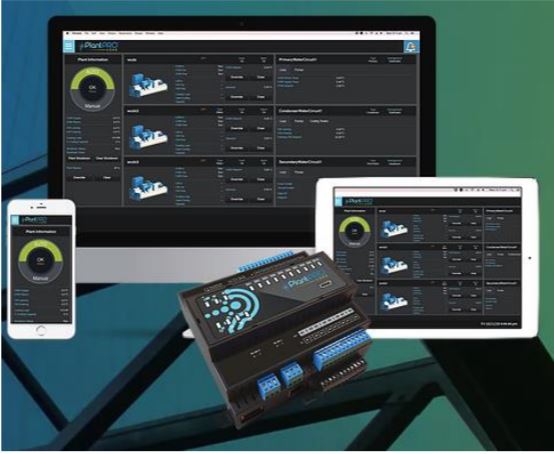|
May 2019
AutomatedBuildings.com
|
[an error occurred while processing this directive]
(Click
Message to Learn More)
|
|
A Lightweight Yet Informative HTML5 User Experience
Using a standard naming convention defined by the haystack
tags7. These tags are also referred to as semantic tags or metadata
tags and were developed and agreed upon by the Project Haystack8
community, where Conserve It is a founding member9
|

Pravesh Badjoonauth,
Product Support Manager,
Conserve
It
|
Introduction to HVAC Systems
In
commercial buildings, HVAC is by far the most energy intensive system,
accounting for close to half1 of the total energy consumption.
HVAC
systems, however, are vast and typically consist of several smaller
subsystems that are intended to be integrated all together and work in
a synergistic manner. These subsystems are categorised into Air Side
systems (E.g. AHUs, FCUs) and Water Side Systems (E.g. Chiller Plants).
A
Chiller Plant comprises equipment such as Chillers, Pumps, and Cooling
Towers and is an integral part of a building’s HVAC system being
responsible for maintaining the indoor building space conditioned at an
appropriate temperature. Consequently, chiller plants account for a
sizeable chunk or around 65% of the building’s HVAC system electrical
energy consumption.
For
this reason, every efficiency improvement in HVAC performance,
including Chiller Plant performance, can significantly reduce the
energy profile of the building, turning HVAC optimisation into a value
generating opportunity. Typically hidden away in plant rooms, HVAC
systems can be complex, challenging and are frequently overlooked.
Energy saving opportunities are often missed in this complex technical
arena. This is where Conserve It2 comes into the picture and
helps
unlock the energy saving potential of a building’s HVAC system through
state-of-the-art IoT solutions developed in-house.
Introducing Conserve It and PlantPRO
Conserve
It, an organisation headquartered in Melbourne, Australia identified
the need for a solution that will not only provide better visibility
into how the energy inside a plant room is being consumed but also take
full control of the chiller plant equipment and operate the most
efficient equipment at their optimum operating efficiency. This
solution was baptised as PlantPRO3. Created with an in-depth
understanding of all thermodynamic variables involved in managing plant
room HVAC equipment, PlantPRO enables complete and optimum control of
every device and its integration into a single synergistic system, with
added functionality for Measurement & Verification, Maintenance
& Diagnostics and Reporting and Charting.
PlantPRO - Global Installations by
Industry

PlantPRO – Global Footprint

Cost
Matters
As
with any product, quality comes at a price, and the PlantPRO solution
is no different. PlantPRO is a specialised solution developed by
engineers and software developers in conjunction with HVAC specialists
with over 30 years of experience in the trade and the effort put in to
develop the PlantPRO solution does translate into a high investment
cost by Conserve It and a justified product price tag as a result.
Despite its price, however, PlantPRO has been well received globally
and as a testament to this has been deployed in over 200 locations
worldwide and has received multiple industry awards and nominations.
With its numerous built-in optimisation strategies, PlantPRO has
achieved energy consumption and cost reduction of over 30% which
generally covers the cost of the PlantPRO solution within a short
payback period. Nevertheless, it cannot be denied that for anyone
looking at acquiring the PlantPRO optimisation solution will be looking
at a sizeable upfront investment, and this upfront cost can be a
hindrance for cost-sensitive projects such as those with smaller
footprints or projects in emerging markets. This is why Conserve It
developed and released PlantPRO
CORE4 – a low cost, high feature
chiller plant control system that retains many of the good bits of the
full PlantPRO solution.

PlantPRO CORE – Low Cost, High Feature
PlantPRO
CORE incorporates the trusted and proven control algorithms of PlantPRO
with a lightweight yet informative HTML5 user experience. As with
PlantPRO, PlantPRO CORE includes the ability to control chillers, pumps
and cooling towers in a very wide array of plant configurations. Users
are able to monitor current plant operating conditions in PlantPRO core
via a responsive HTML5 user interface on either desktop, mobile or
tablet without the need for JAVA or similar supporting software.
Included in PlantPRO CORE are the reliable charting and alarming
features which allow end users to chart historical data effortlessly
and be informed of any anomalies in their system.
PlantPRO CORE – Deployment
PlantPRO
CORE has been developed on Tridium’s5 Niagara Framework and is
deployed
on Conserve it’s highly reliable edge IoT controller - the CI-5346
series hardware. The CI-534 provides 34 points of onboard IO and is
expandable allowing for up to a grand total of 306 points of IO. The
CI-534 controller supports all standard IP Protocols such as BACnet IP,
Modbus TCP and LON over IP and as such facilitates integration with
most BMS systems in the HVAC industry.

PlantPRO CORE VS BMS/BAS
PlantPRO
CORE is intended to operate in the same sphere as Building Management
Systems (BMS) or Building Automation Systems (BAS) and inevitably the
question that gets asked is why to opt for PlantPRO CORE when the BMS
system can complete similar functions. Whilst this is a fair question,
there are actually many factors that differentiate PlantPRO CORE over a
typical BMS/BAS. These can be broken down into distinct categories as
described in the table below.

PlantPRO CORE – Haystack Compatibility
As
outlined before, PlantPRO CORE is fully Haystack compatible which means
that all sensor data points within PlantPRO CORE are tagged using a
Haystack tag. Tagging is a methodology for defining the meaning of
smart device data or put simply it allows the vast amount of
information coming from sensors into PlantPRO CORE to easily be
identified using a standard naming convention defined by the haystack
tags7 . These tags are also referred to as semantic tags or metadata
tags and were developed and agreed upon by the Project Haystack8
community, where Conserve It is a founding member9 alongside companies
such as SkyFoundry and Lynxpring and Board Members such as Intel and
Siemens.
[an error occurred while processing this directive]References
1.
https://www.energy.gov.au/publications/hvac-factsheet-energy-breakdown
2.
https://www.conserveit.com.au/
3.
https://www.conserveit.com.au/plantpro
4.
https://www.conserveit.com.au/plantprocore
5.
https://www.tridium.com/
6.
https://www.conserveit.com.au/edge
7.
https://project-haystack.org/tag
8.
https://project-haystack.org/
9.
https://project-haystack.org/about
About the Author
Conserve
It Product Support Manager, Pravesh Badjoonauth, graduated
with a Bachelor of Engineering (Electrical) from RMIT University. He
joined Conserve It in 2012 and has been promoted a number of times over
the years before taking on his current role in July this year. Conserve
It provides a wide range of products and services including monitoring,
reporting and controlling air conditioning and boiler plants to
minimise energy consumption. Today the company has diversified into
complete HVACR plant management. Since joining Conserve It Badjoonauth
has continued to hone and refine his skills at a rapid pace and today
is a certified global product trainer, system design advisor,
commissioning specialist and technical team leader.
footer
[an error occurred while processing this directive]
[Click Banner To Learn More]
[Home Page] [The
Automator] [About] [Subscribe
] [Contact
Us]
